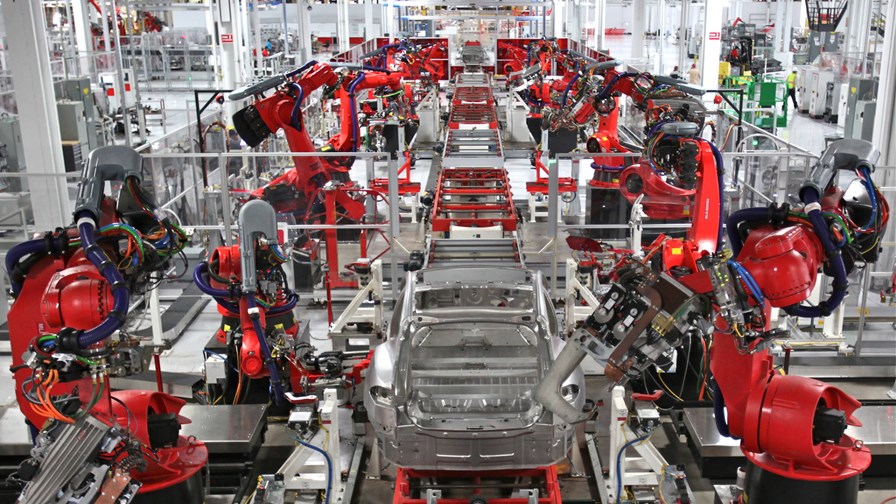
© Flickr/cc-licence/Steve Jurvetson
- Collaborative robots are the way forward says new report
- Cognitive systems allow them to climb decision trees
- However cobots are expensive and difficult to work with
- Market sector to be worth $13 billion by 2017
A "cobot" is a robot that collaborates. Now, you might think that's what all robots are supposed to do since we humans design, build and program the things to do our bidding but according to a new report from research company ABI, "collaborative robots" that utilise cognitive systems and "decision trees" are "one of the most dynamic sub-sections of the robotics industry" and a wave of the future.
Cobots are intended to physically work with and interact with humans in a shared environment or workspace, unlike robots that are programmed to do repetitive and limited tasks autonomously in a largely non-human environment.
Amusingly, and perhaps worryingly, the report says that cobots are "expensive and quite difficult to work with" (a bit like some work colleagues perhaps?) and adds that it is "challenging to set up a solution that uses multiple collaborative systems." I refer the reader to my previous observation and the current shenanigans in the British body politic.
Apparently though, cognitive systems architectures, which are responsible for the work of knowing, understanding, planning, deciding, problem-solving, analysing, synthesising and judging" among other "humanlike" (or, actually, just plain human) capabilities are making it easier for human operators to use cobots. ABI says cobots have evolved from being "interesting novelties" to a "key emerging market" in less than 10 years. I wonder if they know?
The availability and use of cobots is expected quickly to accelerate in coming years and it is forecast that the global cobot market, which last year was worth just $500 million will grow to a value of $13 billion by 2027. The biggest markets currently are in the US and the UK but the APAC region is expected to be the primary engine of sector growth with China taking the lead in the near future.
Original Press Release:
Cognitive Systems fuel the future of robotics industry, as cobots morph into a billion dollar market
London, United Kingdom - 18 Jul 2018: There is a growing interest within the robotics industry as to the benefits of cognitive systems and how they can improve robotic solutions, both in the incremental sense of improving productivity and the strategic sense of adding entirely new capabilities that broaden the use-cases for robotics in the traditional parameters of the industry and beyond, finds ABI Research, a market-foresight advisory firm providing strategic guidance on the most compelling transformative technologies.
The innate value of cognitive systems run concomitant to the development of collaborative robotics. As one of the most dynamic sub-sections of the robotics industry collaborative robotics, aka ‘cobots’, have gone from an interesting novelty to a key emerging market within less than a decade. “While collaborative robots have ceased being a novelty, we expect their adoption rate to accelerate in the coming decades, going from a relative outlier in the larger industry to a central pillar,” said Rian Whitton, Research Analyst at ABI Research. “Currently less than US$500 million in global revenue in 2017, the cobot market will grow considerably -- to nearly US$13 billion in 2027. The largest markets now are in Europe and the United States, but the APAC region will be the primary source of growth for the future, largely as a reflection of China’s increased adoption of robotic solutions.”
With all this growth, two questions arise: What improvements need to be made to collaborative systems? And, how can cognitive systems add value while solving problems? The answer to each is wide-ranging and complex but can be simplified into two broad issues. Collaborative robots themselves remain expensive and often quite difficult to work with, and at the larger level, it is challenging to set up a solution that uses multiple collaborative systems.
Already, cognitive systems are making it easier for human operators to interact with and utilize collaborative robots. Cognitive systems are defined broadly as an architecture that is responsible for the cognitive work of knowing, understanding, planning, deciding, problem-solving, analyzing, synthesizing, assessing, judging, and other human-like capabilities. Visual programming interfaces that utilize decision-trees are ending the need for advanced coding or programming to change and eschew commands, while software applications are increasingly leveraging sophisticated simulation. As an example of machine-vision innovation, Veo Robotics is developing a sophisticated plug-in system that will allow human operators to interact with large, powerful industrial robots, such as those used to weld car parts or home appliances. The company is attempting to break the tyranny of safe/unsafe zones, making all robots more collaborative through advanced AI technologies like object recognition and semantic modeling.
At the same time, IIOT platforms and software providers are helping companies ingest large quantities of data and gain requisite insights. This can amount to improvements in strength optimization, materials handling, defect detection and predictive maintenance.
When these solutions are incorporated into an effective IoT platform, the efficiencies can be impressive. Japanese Industrial giant Fanuc claimed that its bespoke FIELD edge-based IoT platform, in an 18-month partnership with an automotive manufacturer, reduced unplanned downtime by a rate of US$20,000 per minute.
“Though an exciting technology, collaborative robots need to improve considerably to reach the expectations set by the wider industry and to provide smaller end-users with genuine robotic solutions. Leveraging cognitive systems via software development kits (SDKs), IIoT platforms, and human-machine interfaces will be the primary way of achieving that moving forward - with value shifting from hardware to software,” concluded Whitton.
These findings are from ABI Research’s The Use Case of Cognitive Systems in Collaborative Robotics report. This report is part of the company’s Robotics, Automation & Intelligent Systems research service, which includes research, data, and Executive Foresights.
Email Newsletters
Sign up to receive TelecomTV's top news and videos, plus exclusive subscriber-only content direct to your inbox.




